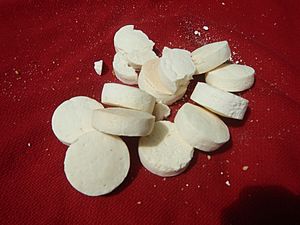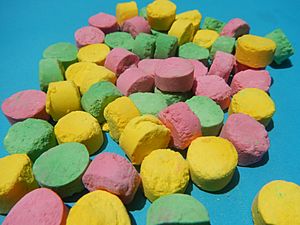Puto seco facts for kids
 |
|
| Alternative names | puto masa, puto seko, dry puto, coconut angel cookie |
|---|---|
| Type | Cookie |
| Place of origin | Philippines |
Puto seco (say "POO-toh SEH-koh") is a yummy Filipino cookie. It's also known as puto masa (say "POO-toh MAH-sah"). These cookies are made from special ground glutinous rice, cornstarch, sugar, salt, butter, and eggs. They are usually white and shaped like thick, round disks. When you eat them, they feel dry and powdery in your mouth, which is part of their unique charm!
Contents
What's in a Name?
The name puto seco comes from two languages. "Puto" is a Filipino word for traditional Filipino steamed rice cakes. "Seco" is a Spanish word meaning "dry." So, puto seco literally means "dry puto," which describes its texture perfectly! You might also see it spelled as "puto seko."
How Puto Seco is Made
Traditionally, puto seco was made from galapong. This is a special kind of ground glutinous rice that has been soaked in water overnight. Today, many people use rice flour or all-purpose flour instead.
The flour is mixed with cornstarch, butter, eggs, salt, and sugar. Sometimes, milk is added to the mix too. After everything is mixed well, the cookies are baked until they become very dry and a bit crumbly.
Different Flavors and Colors
Modern puto seco cookies can come in many fun flavors. Some popular ones include ube (purple yam), coconut, and buko pandan. These flavors add a delicious twist to the classic cookie.
You might also see colorful, candy-like versions of puto seco. These are often called puto masa. The word "masa" here means "dough." This colorful type of cookie is very popular in the Philippine provinces of Laguna and Batangas.
Cookies Like Puto Seco
Puto seco is similar to other traditional powdery cookies found in the Philippines. Some of these include masa podrida and uraró. They all share that unique dry, melt-in-your-mouth texture.


